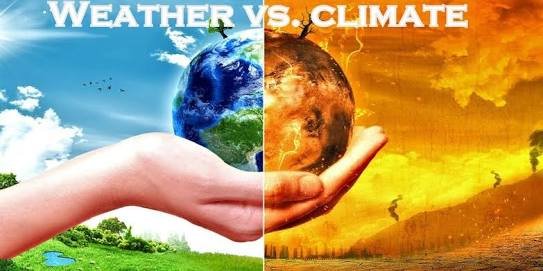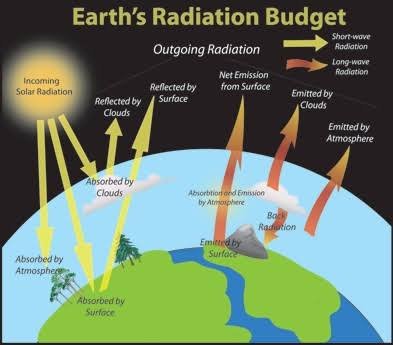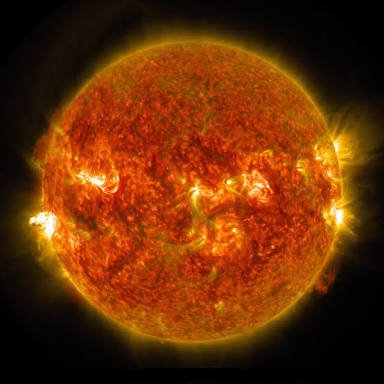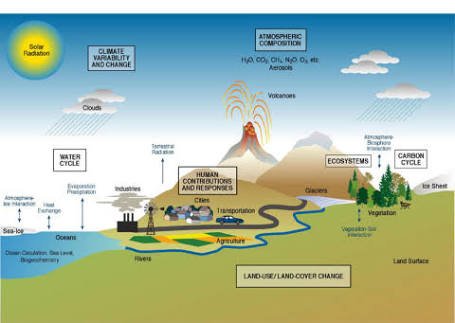Weather And Flimate Are the Elements That Are the Main Topic Of Discussion
Before I discuss the elements of weather and climate that will be the topic of conversation in my tears, it would be better if I discuss the understanding of the weather and the climate itself. Maybe we've often heard the word weather and also the climate in everyday life is not it? If we are going to do an activity, the first thing set is weather. Because of the importance of weather, until there is a highly anticipated weather forecast report on the news in the morning.
Weather is a state of air somewhere at a given moment. All the time, the weather in every place is different and constantly changing. While climate is the average state of weather and air in the long run, it ranges from 10 to 30 years. Climate usually also covers a larger area than the weather. That's the understanding of weather and climate. Observations of weather and climate are also conducted by the Meteorological and Geophysical Observatory. The Meteorological and Geophysical Observatory Agency has a duty to investigate and record weather conditions that include air temperature, air pressure, wind direction, wind speed, air humidity, cloud level and rainfall conditions.

After knowing the understanding of weather and climate, I will discuss the elements of weather and climate. Weather and climate have the same elements. Why do we need to learn about weather and climate elements? What are the benefits we will gain by studying weather and climate elements? Knowing about weather and climate elements will be very beneficial for us, such as agriculture, aviation, shipping, and for the launch of objects into space.
Radiation and Temperature
The weather element and also the climate are radiation and also temperature. This irradiation will definitely be associated with sunlight and get to earth. The sun's shining process on Earth is called insolation. While the matahar radiation is on Earth, the Earth will experience warming called radiation. While temperatures will be associated with the air pressure that exists in a place. Everyone knows, that the biggest source of radiation for Earth is the sun. Sunlight has a very important role for survival on Earth. Each hemisphere gets sunlight different from each other.Circumstances
Circumstances are important determinants of sunlight reaching Earth. Cloud status will be the determinant of much sunlight that can be accepted by the earth's surface. If the clouds are cloudy, some of the sun's heat will be absorbed by the cloud, so that the surface of the earth will not get the maximum irradiation, and the temperature on the earth's surface will be lower than other areas that get maximum sun exposure.The State Of the Earth's Surface
So the determinant factor so much sunlight that enters the surface of the earth is the state from the surface of the earth. Earth's surface aircraft consisting of land and sea affects the absorption of sunlight. The soil will quickly become hot when exposed to sunlight, compared with the oceans.The Angle Of the Sun
In addition to the state of the cloud and also the state of the Earth's surface, the angle of the arrival of the sun is also much affect
at least sunlight entering the earth's surface. As the sun stands, the sun's arrival angle will be smaller, so the heat that Earth receives will increase. And as the sun is tilted, the angle of the sun gets bigger, consequently the heat the Earth receives will decrease.The Duration Of Solar Radiation.
The duration of radiation from the sun also greatly affects most of the heat that will be transferred to Earth. The sun that shines longer will provide more heat than the sun's rays that fly only briefly. And the heat the Earth receives also increases, the air temperature on Earth is also increasing or higher.
Here are some of the causes of heat that Earth receives. Radiation and also temperature are two very related things. Why? Because of exposure to sunlight will increasingly cause the temperature on the surface of the earth is increasing. Then, is there a difference between solar heat reception by the surface of the earth and also the oceans?

Mentioned earlier that the plains will more quickly absorb heat than the oceans. During the day, the land will quickly become hot, but at night the ground will quickly become cold. The state of various temperatures can certainly be measured using the Thermometar tool.
Wind
The wind element is moving air. Air movement caused by temperature difference, which in turn causes changes in air pressure until wind occurs. Air pressure will rise when the temperature is low, and the air pressure will drop when the temperature is high. The wind will move from the high pressure area to the lower pressure area.Clouds
Clouds are a large collection of water droplets or fine ice crystals in the atmosphere. The rising air will slowly cool down, so that the air humidity increases. When it reaches a certain height, then the air will be saturated with water and then it will turn into a cloud. During the dry season, we will meet a small number of clouds, this is due to very little evaporation. But during the rainy season, the clouds we encounter are numerous, this is because evaporation is also a lot.Humidity
Air humidity is the least water vapor in the air. This humidity will affect the deposition of water in the air and can also be clouds, fog, dew and rain. Air humidity in place can be measured using a special tool. The tool used to measure the humidity level of the air is called hydrography. Air humidity itself consists of two types, namely relative humidity and absolute moisture.Rainfall
The last element of weather and climate is rainfall. Rainfall is the rate of rain that falls in an area. Rain events are characterized by water droplets from clouds formed by solar radiation to water sources such as the ocean or oceans, lakes, rivers, reservoirs and so on. The water source will evaporate and become evaporated. As water vapor rises because of the wind, then at a certain height the water vapor will turn into a cloud. And as the clouds rise, the clouds will saturate and release their water loads like rain. The direction of rain in a region can be measured using a device called an obrometer.
Those are some elements of the weather and also the earth's climate. These elements can always be found on this Earth and will affect the things that exist on Earth, until the Earth can be perceived by humans and other living things.
Once we know about weather and climate elements, it's good we know about the type of climate in the world. Geographical location as well as atronomic, physiographic. Environment and atmospheric conditions of an area affect the climate of a region. Basically, the climate is divided into two kinds, namely the climate of the sun and climate physics. Then the climate of the sun and also the climate of physics will be divided into several more we know as the type of climate. Some types of climate in the world are as follows:

A) The Sun Climate
The climate of the sun is one of the basic types of climate. The basis for calculating the division of the sun's climate area is the position and shifting pseudo-sun that affects the amount of sunlight received by the Earth's surface. Since the sun always shifts between latitudes, there is a difference in irradiation on the surface of the earth. This is the division of climatic regions based on latitude locations:
Tropical Climate
Tropical climate is the most hot climate, where the tropical climate gets the most sunlight than any other type of climate. The tropical climate is a shining climate in areas in the region of 23.5 ° N to 23.5 ° LS.
The most viscous tropical climate feature has only two seasons, the rainy season and the dry season. Both take place each for 6 months in turn.Sub-Tropical Climate
Sub-tropical climate, is a climate located in an area that has a latitude of 23.5 ° N to 40 ° N and between 23.5 ° LS to 40 ° LS. Unlike tropical climates, sub tropical climates get a bit of solar heat. The sub-tropical climate also not only has two seasons like the tropical climate, but has four seasons, namely summer, autumn, winter and spring.Moderate Climate
Moderate climate is a climate of latitude between 40 ° N and 66.5 ° N and 40 ° N to 66.5 ° E. This climate is less sunshine than tropical or sub-tropical climates.Polar Climate
The polar climate is a climate possessed by polar regions with latitudes ranging from 66.5 ° N to 90 ° N and 66.5 ° E to 90 ° E. This polar climate is only possessed by the north pole region and also the south pole. This polar climate is the climate of ice, where there is only ice and snow everywhere. Not many living things survive in this climate, only certain animals and plants.
It's a kind of sun climate. Of the four types of climate above each has its own characteristics.

B) Physical Climate
The second type of climate besides the sun's climate is the physical climate. Physical climate is a climate in which the division is based on actual facts or conditions in an area caused by the influence of its natural environment. Physical climate is divided into several types.
Climate Of the Sea
Climate is a climate that is owned by the area around the sea or has many marine areas. The ocean climate is strongly influenced by sea breezes, so the temperature of the air in this climate-dependent region depends on sea conditions.Climate Land
Soil or continental climate, opposite of sea climate, this climate is the continental climate or continental climate. This climate includes areas far from the sea. This climate is also affected by the conditions that exist on land.Highland Climate
Furthermore there is a highland climate. As the name implies, this climate is only owned by areas in the highlands. The plateau region has a cooler air temperature and also lower air pressure. Highland climate has cold air, consequently not all types of plants can live in this area. Only plants that are habitats in cold areas that can live, such as tobacco, apples, strawberries and so on.Climate Mountains
Mountain climate is a climate that includes mountainous areas. Just like highland climate, mountain climate also has cold temperatures and low air pressure. It's just that this mountain climate is at a higher altitude than the plateau.Season Or Rainy Climate
The next climate is the seasonal climate or monsoon climate. This climate is the corresponding climate of the season. And this is one type of physical climate.
So, that is the type of climate that is divided into two kinds, namely the Climate Of the Sun and also the Physical Climate. Climate like this we need to know and learn to improve our knowledge and insight.

Note: All letters and numbers are mine, but the picture I got from google, I just use it to connect from my writing.

About The Science I Have Written:
Science: | Science: | Science: | Science: | Science: | Science: | Science: | Science: | Science: | Science: | Science: | Science: |
Hey there, I had a quick look at the article, you make some interesting points, it's interesting to read about the different types of climates.
However you need to ensure that your images are fair use or creative commons. You notice on this website it says you must ask them for permission to use the images, you'll see at the bottom. If you'd like upvotes from steemstem you need to ensure you are using free images.
Also, just a suggestion, try to make the different sections clear, have and introduction and a conclusion section for example. This way readers who don't read the full article can see an intro and a conclusion (some people do this).
Hope the advice helps, have a good day and see you around :)
Very useful, thank you for your suggestion.
But, I read articles about science on various sites, then I assemble and write in my article, more details, I quote.
About the image, why I write Source image / referance? because there I get about the science I write. So, I put the image address, as well as a reference from my writing.
if it's against the rules, how should I get a free image?
I am not a researcher, and I also do not have a laboratory to take pictures as sample.
Give me guidance.
Let us know what sites you used, that way we can read a bit more about the topic.
Have a read about fair use images and creative commons. Wikimedia is a good place to find a lot of images, most of mine are from here.
I have seen and read your article on this one: https://steemit.com/steemstem/@physics.benjamin/the-wonders-of-the-electro-magnetic-spectrum-light-interaction-why-you-see-the-colours-you-do
now I understand, I will do it in my writing in the future.
thank you for your suggestion, this is very useful for my writing.
Personally, I can recommend using PixaBay and Pexels.
They offer "free", "CC0" images. (Creative Commons, 0)
And Wikipedia can be a good source of "CC-BY-SA". (Creative Commons, By Name, Share Alike)
Here, simply state
Par example:
"Mr. Ding Dong, Wikipedia, CC-BY-SA. [Hyperlink to source]"
"PixaBay.com, CC0 License. [optional Hyperlink to source]"
You got a 7.72% upvote from @upmewhale courtesy of @youngky! Earn 90% daily earning payout by delegating SP to @upmewhale.
Congratulations @youngky! You have completed some achievement on Steemit and have been rewarded with new badge(s) :
Click on any badge to view your own Board of Honor on SteemitBoard.
To support your work, I also upvoted your post!
For more information about SteemitBoard, click here
If you no longer want to receive notifications, reply to this comment with the word
STOP